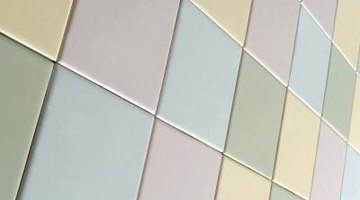How to Remove the Metal Lath Layer From a Bathroom
A metal lath layer lies under tiles and a coating of mortar. Tile installers nail lath to the studs or subflooring in a bathroom to give the mortar a good gripping surface. Many homeowners choose to remove dated or damaged bathroom tile and replace it with modern, updated tile or other types of floor and wall coverings. After removing the tile, revealing an uneven, rough surface is common and requires you to remove the mortar and lath layer before you refinish the walls or floors.
Preparation

-
Take out all items from the bathroom that you can easily remove.
-
Protect the sink, toilet, mirrors, medicine cabinet and tub with two to three layers of thick cardboard duct-taped to hold the cardboard in place.
-
Remove the bathroom door from its hinges and take it out of the bathroom. Duct-tape a tarp or plastic sheet to cover the doorway.
Hammer and Chisel
-
Hold a cold chisel at a low angle on the grout line next to the tile. Hit the chisel with a hammer to break the tile out of position on the floor or wall. Repeat the process for two to three surrounding tiles. If the tiles are located on the wall, continue to break the tiles away from the walls with a hammer and cold chisel until no tiles remain on the wall.
-
Place a coal shovel or floor scraper on the mortar with the edge of the shovel or scraper facing the intact tiles. Hit the top of the scraper or coal shovel's handle with a hammer to wedge the shovel or floor scraper under the tile and pop or break the tiles. Continue to wedge the shovel or floor scraper under the tiles and break or pop them out of position until no tiles remain. This method is more effective on floors than walls. Remove the tile debris from the bathroom and discard it in a dumpster.
-
Strike the mortar with a 2-lb. masonry hammer to crumble and break the mortar. Begin at the edge of the floor or a corner of the room. Do not strike forcefully until you've determined whether plumbing pipes or electrical wires lie behind the mortar and lath. Continue to strike the mortar and break it off the wall or floor. This will expose the metal lath, with some mortar remaining stuck to the mesh. Use greater force in the areas where you are sure there are no pipes or wires. Remove the mortar debris from the bathroom and discard it in a dumpster.
-
Hit the surface along the face of the studs to crush and remove any remaining mortar and expose the nail heads. Pull the nails holding the lath out of the studs or floor, using a claw hammer or nail puller. Continue to pull the nails to free the lath until no lath remains on the walls or floor.
Circular Saw
-
Strike the center of a wall or floor with a 2-lb. masonry hammer to break the tile and mortar. Continue to hit the same area until you've punched a hole through the wall or floor. Use care not to break through in one swing in case plumbing pipes or electrical wires lie behind the wall.
-
Measure the distance from the face of the tile to the bottom of the lath, using a tape measure.
-
Turn off the electrical power to the bathroom from the breaker box. Hang a drop light plugged into a receptacle in another room to provide adequate lighting in the bathroom.
-
Put a masonry saw blade in a circular saw. Set the depth of the blade 1/8-inch deeper than the wall's thickness.
-
Place the saw up against the wall at the point where you created a hole, and saw up toward the ceiling, down toward the floor or across the floor. Cut the tile, mortar and lath into 2-foot by 2-foot sections. Sections between wall studs will fall to the floor. Place a pry bar behind sections attached to the wall studs, and pry them away from the wall. If the tile is on the floor, scrape the cut sections off the floor with a coal shovel or floor scraper.
References
- "Bathrooms"; Time Life Editors; 1994
- "Reader's Digest Complete Do-It-Yourself Manual"; Family Handyman Magazine Editors; 2005
- "The Book of Skills and Tools"; Family Handyman Magazine Editors; 1993
Tips
- Replace mortar and lath with cement backer board.
- Place a small throw rug outside of the bathroom so you can wipe the bottoms of your boots and avoid tracking debris through the house.
Warnings
- Wear a hardhat, ear protection, safety goggles, leather gloves, a dust mask, a long-sleeve shirt, long pants and work boots.
- Handle broken tile and metal lath wire care, as both are very sharp.
Writer Bio
Sal Marco began writing professionally in 2009. He has written many online home improvement articles based on his more than 20 years of experience in the home improvement and building industries. He has worked as both part of a team and as a site supervisor. Marco has a Bachelor of Science in management science from Kean University.
Photo Credits
- Liquidlibrary/liquidlibrary/Getty Images
More Articles



